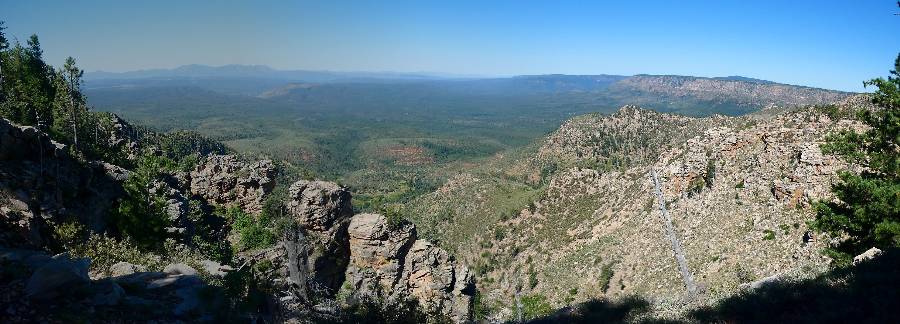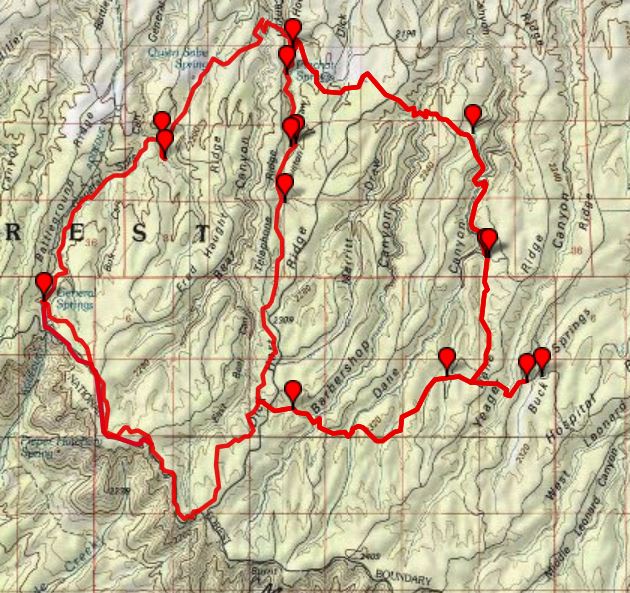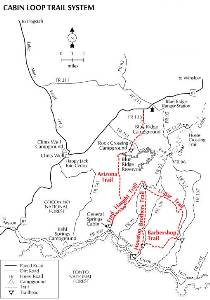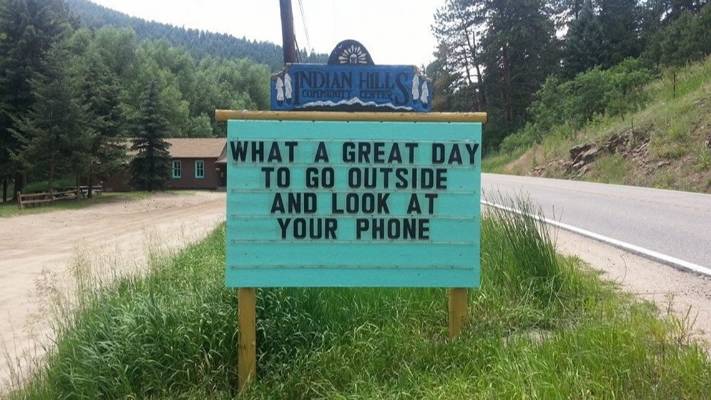Circle Your Cabins: Coconiño Cabin Loop Backpack:
Circumnavigating Six Historic USFS Cabins near the Mogollon Rim
Another in the antisocial social distancing series, in these days of the MAGAvirus
by Rob Jones, Wild Vagabond
July 27 - 29, 2020
Text
© copyright by Rob; and Photos © copyright by Rob Jones
|
 |
Total loop = 31.3 miles. ERM = 52.2
Co-adventurer - Solo jaunt
Camera - Panasonic ZS-70

|
|---|
Panorama from the Mogollon Rim, looking South/SW
(Click the image for the full-size image)
|
|---|
|

|
|---|
General Springs Cabin
(Click the image for the full-size image)
|
|---|
|

|
|---|
Fred Haught Cabin site
(Click the image for the full-size image)
|
|---|
|

|
|---|
Pinchót Cabin
(Click the image for the full-size image)
|
|---|
|

|
|---|
Aspen Cabin
(Click the image for the full-size image)
|
|---|
|

|
|---|
Dane Cabin
(Click the image for the full-size image)
|
|---|
|

|
|---|
Buck Springs Cabins
(Click the image for the full-size image)
|
|---|
|

|
|---|
Flower Companions
(Click the image for the full-size image)
|
|---|
|

|
|---|
Coconino border in Barbarshop Canyon
(Click the image for the full-size image)
|
|---|
|

|
|---|
Movie 1: Aspen Spring, 16mb
(Click the image to see the short video)
|
|---|
|
.



|
|---|
Map - Coconiño Cabin Loop (large file, 6.4 mb) - from my Gaia mapping program
you should be able to print this map as a handy reference
(Click the image to see the map)
|
|---|
|
Another version of the map can be found here.
This version can be enlarged and may be more useful than the above map ----> click here.
Overview: Backpacking the Coconiño Cabin Loop is yet another
short adventure close to home that makes the most of social distancing and not impacting others during these constrained
times of the MAGAvirus, the EtV (Evil trump Virus). This report is about circumnavigating the loop and visiting six historic
USFS cabins near the Mogollon Rim in Coconiño National Forest, Arizona. It contains photos, narrative, videos, historical stuff,
and commentary. Enjoy.
It's a short outing, yet one I enjoyed because of impending cabin (hah) fever meltdown. Here's the report, along with some photos, etc.
Tips for hiking the Cabins Loop:
Hike on weekdays to avoid most of the race trucks, ATV/ORV noisy terrain destroyers, and winnehogo tin can tourist crowd, which can seriously impact your circle experience. There are spur roads to most of the cabins, so you might want to camp away from them. Note that much of the General Crook Trail in this circle hike borders FR300, a very busy road (again, hike on weekdays).
Here is my water report from this trip.
Sources preceded by a ** are considered probable water sources.
Water: (note that this hike was after some rain)
General Springs - dry.
General Springs Canyon - pools, alum a great idea.
** Fred Haught - in drainage, OK, moss.
Quien Sabe - dry.
** Pinchót Cabin - good flow.
** Aspen Spring - clean and cold low flow near cabin.
Barbershop Canyon North - good clear flow. Near Merritt Draw.
McClintock - poor access, dry.
Dane Canyon - dry.
** Dane Spring by cabin, superb.
** Buck Springs - muddy, need alum.
** Coyote/McClintock Draw - nice trickle. Need dipper.
Barbershop Canyon, upper, South - pools.
** Barbershop Spring - steady clear low flow.
(I did not visit McFarland Spring, South of Aspen Spring)
Link to use of alum to clarify water (get out the mud and silt) prior to treating it. (Click here.)
ERM = Energy Required Miles. A mile is added for
every 500' elevation gain or
loss. It's a very serviceable method of estimating energy required miles. ERM was initially used in Trails
of the Tetons (long out of print) by Paul Petzold, founder of NOLS. It's a wonderfully useful concept and
application. Add one mile for each 500' up AND down to distance = ERM. I use ERMs to calculate what the actual
day is like. It's a very serviceable method of estimating energy required miles. Remember, however, that the
ERMs are estimates because they depend on GPS satellite coverage and math functions.
Using ERMs does not account for the 'texture' of the route or trail - that
is, rocky, boulders, no trail, slimy mud, etc., yet does help approximate the route.
See more information about ERMs at the end of this report.
Day 1: Finding the Forest Service Founder, Pinchót. Visiting General Springs, Fred
Haught, Pinchót, and Aspen Cabins
11.6 miles; up 1750', down 1600'; ERM = 18.3. Camp @ 7050'.
Early driving on Coconiño FR141 to FR141H to the 300 (FR300) and then the short
spur to General Springs Cabin puts me onto the path of the cabins; the dust swirling and the Subie Subaru slithering switchbacks
and pounding the washboard roads. FR is Forest Road.
My plan is to backpack the Cabins Loop, a 33 mile (outside perimeter) path that visits
six historic USFS (Forest Service) patrol and guard stations nestled in the system of canyons near the Mogollon Rim on the
Coconiño National Forest. Hurrah for public lands, especially the untrammeled kind.
Spectacular.
Starting North on the AZT, Arizona Trail, from General Springs Cabin, the path is obvious
and in good condition, thanks to the volunteers and stewards of this fantastic National Scenic Trail. Thanks.
Link to the reports about my Quest to Hike the AZT. (Click here.)
I've drafted my route after a pleasant discussion about this loop with Amelia of the USFS.
Amelia sends some cabin history and a sketch of the trail and probable water sources - very helpful. I download the maps along
the route and print a paper copy, then wait for a break in the monsoonal flow, then go!
Lilting down General Springs Canyon on the gorgeous AZT is a joy.
I'm walking on sandy loam. What a contrast to the typical AZT tread of Idaho topsoil, 90% rocks, 10% dirt.
Bracken Ferns border the trail. Sometimes they are waist high, or higher.
The cabin loop diverges from the AZT and onto the Fred Haught Trail.
Soon, there's a spur to the Fred Haught Cabin site, now merely a chimney and the
hint of a foundation. The Fred Haught Spring is in the drainage near the junction with the main loop trail. The trail climbs
out of the brief bit in Fred Haught Canyon and then downstream in Quien Sabe Draw before bumping over into Bear Canyon.
With the third road crossing today, the trail joins the road to the Bear Canyon blowout.
Blowout is correct, a yuge section of the road is gone, effectively forming a barrier to vehicles and improving the hiker experience.
Soon the Pinchót Cabin and its glorious scenic toilet appear. Just the right time for
a late lunch and to guzzle some Pinchót water. Just prior to reaching Pinchót Cabin, I talk with the two hikers of today who
are day hiking this section.
Up Houston Draw I hike (South) a short distance to near Pinchót Spring, which burbles
out from beneath a limestone boulder. This location should be far enough from the tentacles of forest roads to provide a
suitable camp. I set up the TarpTent and hang the Bear bag and continue up the draw to Aspen Spring Cabin. Three aspens
stand watch over this cold trickle, again emanating from a scrum of limestone boulders. Excellent water. These sentinels are
the only aspens that I see in the area.
Perhaps the main Aspen Cabin is gone? I'm wondering about this because there's an
ornate chimney, standing solo, while downslope is perhaps an early cabin or a shed to accompany the missing cabin?
Back to camp, the bucket of water that I hung in a P-pine is just the right temperature
for a bath. Lovely.
Then, some note writing while Cheesy Spinach Dip, a Knorr pasta side, cooks. What a
fantastic evening, allowing for some lounging in the skin. Deluxe.
That is until a dark cloud roves overhead and thunder cracks to the East. A few drops
cause me to wrap up some of the drying equipment. I continue eating, until.....
The thunderstorm arrives suddenly, sneaking in from behind me and opening up
without further warning. Yikes. I grab my umbrella and get most things into the tent or its vestibules. My hiking clothes get
wet in the process. So much for that break in the monsoonal flow. Argh. Its all quiet on the Western front in half an hour,
although Thor rumbles off by Aspen Spring. Now dark, it's an excellent time to listen to the faint trickle of water from Pinchót
Spring and the assorted natural quiet. Hurrah. Some belching frogs crank up their love calls as the last of the rain drips off
the P-pines.
Day 1 photos - Cabin Loop
Day 2: Undulating. Barbershop return. To Barbershop Spring. Visit Dane and Buck Springs Cabins
12.7 miles; up 2600', down 2200'; ERM = 22.3. Camp @ 7530'
Undulating through canyons, the deepest dive is lower Barbershop Canyon, on this North
side of the loop. The canyons flow away from the Mogollon Rim, not toward it. So, the next time I dip through Barbershop Canyon,
it should be a more shallow canyon.
Stopping short of (dry) McClintock Spring, I lounge against a venerable P-pine for a snack and
to begin the process of drying the Bear bag and other equipment left out in last night's vigorous storm.
It's a delightfully quiet morning, with the sunlight slanting through the forest. Natural quiet abounds.
The Elk slip through the pine and fir forest like ghosts, avoiding my photographic endeavors.
Now I've bobbed past dry McClintock Spring and through dry Dane Canyon to walk the edge of Dane to the cabin ruins and its spectacular spring water.
A break seems in order to enjoy the water and the ambiance of Dane. Next to the cabin wall,
there's a yuge Douglas Fir that provides a good umbrella from sun or rain, whatever this fickle weather provides. Then, I'm taking a
liter of this superb water with me to the next stop.
It's a good thing that I toted the water from Dane because the water behind the
impoundment at Buck Springs is muddy, in need of alum. It's monsoon season after all, and surges of water bring silt.
The side venture to Buck takes me through Yeager. Yet another of the many canyon
bops today. I'm already dragging when I return to the loop after the side jaunt to Buck Springs Cabins. At Buck, I encounter
the only people I'll see today, a group of four day hikers.
Again, more skirting around and then through Dane The same with Barbershop.
Mostly out of the West slope of Barbershop, I reach diminutive Barbershop Spring, which is cold and clear.
Day 2 photos - Cabin Loop

|
|---|
Movie 2: Dane Spring, 14mb
(Click the image to see the short video)
|
|---|
|
Day 3: Rim Rounder. Completing the Coconiño Cabin Loop backpack. A
dustnote to General Crook
7 miles; up 1,000', down 1300'; ERM = 11.6.
Total loop = 31.3 miles. ERM = 52.2.
The Elk bark hello, interspersed with a few grunts and "eees," waking me for the
concluding day of Circling Your Cabins. I'm probably sleeping in their resting grounds, as indicated by their extensive scat.
And then there's the barking.
Turkeys chuckle to me from somewhere in the undergrowth off to the West. Merriam
Turkeys, named after C. Hart Merriam. So was the now extinct Merriam Elk, driven extinct by livestockers and market hunters.
Yes, the Elk seen hereabouts are not native Elk. They were imported from the Yellowstone region. We have so little for which
to thank livestock people, including our paying for the killing of many of our predator species, those that hold the ecosystem
together. Yes, this is what happens, government killers eliminate all sorts of predators who may share our public lands with
profiteering livestockers. What would happen if welfare ranchers/livestockers paid actual market price for grazing their (private)
livestock on public lands? Well, ranchers mostly vote republican and republicans are famous for "free market solutions." So, how
come ranchers receive yuge welfare, partly via bailout low AUMs? Beef Magazine reported that private grazing rates across the
U.S. were $14.50 per AUM (Animal Unit Month; a cow and one calf) while we are heavily, yugely subsidizing private profit ranchers
by currently charging $1.35 per AUM for grazing on public lands. Plus, we pay for a predator killing service, and for range
"improvement" (such as chaining (ripping out) our trees) which destroys the natural balance on our lands.
Link up to the General Crook "trail." One follows discontinuous metal chevrons
(installed by scouts decades ago) and intuition guided by dead reckoning. Until just South of Dude Lake, where stewards
have crafted an actual trail tread. This tread work is very recent.
Map note - hike the purple track in this section - it crosses FR300 just North of Dude
Lake and borders FR300 back to General Springs Cabin. This is the West line on the map as it crosses FR300. You'll see one of
the "V" (distance) posts near where the trail crosses FR 300 just North of the lake. From the inception of this tread, its a dream to follow
the Crook. Sadly, FR300 is alongside the Crook for way too long, exposing the hiker to race trucks and freedumb ATV/ORV riders
churning the dust, shattering natural quiet. Obviously, it's my least favorite part of this loop. (And the primary reason for hiking
on weekdays.) A dustnote to General Crook. The good news is that this is (mostly) not road walking. The other good news is
that the trail visits the rim for glimpses of the top layers seen in The Canyon (Grand Canyon), and features ranging vistas to the
Matazal Wilderness. Excellent.
Adding to the pleasantness, it's hot. Although during a foot break under an oak, clouds
roll in to improve the outlook on General Crook.
Thankfully, FR300 is quiet today and I enjoy the dalliances at the Mogollon Rim, gazing out
over the area just below that carries the
Haughty Highline Trail (see this trip report, click here)
and the ranging views to the Matazal Wilderness, through which the National Scenic Trail known as the AZT, Arizona Trail, wanders.
Soon, I've completed the loop to General Springs Cabin, reveling in the circumnavigation
that is the Coconiño Cabin Loop.
Day 3 photos - Cabin Loop
.
 .
.
Historical stuff: described in the order one finds these features on the Cabin
Loop, starting at General Springs Cabin and hiking clockwise.
Day hikes: By report, it's possible to visit scenic toilets and to break
up this loop hike into day hike chunks by using the access points shown on the cabin loop access points sketch below (USFS sketch).
A USFS Coconiño travel map or large forest map is useful for negotiating the numerous dirt/gravel roads you will encounter.

|
|---|
cabin loop access points (USFS)
(Click the image for the full-size image)
|
|---|
|
Big Dry Wash: marker (on FR300 at turn to General Springs Cabin): It’s
a quiet place now, but in 1882, a few decades before the cabins were built, the area was the site of the last major battle
between the U.S. Army and the Apaches. In all, more than 20 Apache warriors died, along with two U.S. soldiers. You’ll
pass this memorial to the Battle of Big Dry Wash, erected in the 1930s by the Civilian Conservation Corps, as you approach the trailhead.
The AZT, Arizona National Scenic Trail: Flagstaff's own Dale Shelwalter, a fifth-grade
schoolteacher, walked what would become the AZT in 1985, after spending several years piloting trail sections. The first section
of the AZT was dedicated in 1988, starting from the North Rim of Grand Canyon National Park and running for 54 miles toward
Utah. Other segments followed, and the AZT was officially completed in 2011, 26 years after Dale pioneered the route and one
year after he died. Numerous public land agencies (e.g., the NPS, FS, BLM) and volunteer groups and individuals made the AZT
a reality, starting with Dale's vision. The need for trail and easement work are continuous along the 800 mile AZT, which travels
through almost all C. Hart Merriam's life zones as it rambles from the Mexico border to Utah.
For more about the AZT (see this trip report series, click here)
C. Hart Merriam: As scientists and area nature lovers know, Dr. Clinton Hart
Merriam, America's first bio-ecologist, established the Life Zone concept in 1889 on the San Francisco Mountain of Arizona. When
he was sixteen years old, Merriam accompanied the 1872 Hayden Survey to Yellowstone, and was the founder and first chief of the
U.S. Bureau of Biological Survey, now the Fish and Wildlife Service. Merriam was the first to advance and define the Life Zone
concept in scientific terms. In his report on the San Francisco Mountain region (1890) he concluded that forms of life are dependent
upon altitude zones, and the designation of a region or zone by the presence of animals and plants not found in other zones. Because
temperatures on North slopes differ from those with Southern exposure, life zones do not run on arbitrary contours. Latitude, the
distance from the equator, is also important in determining climate. This combination of altitude, exposure, and latitude (climate) is
basic in the ecology that governs the existing distribution of plants and animal indigenous to the various regions.
Merriam's concept was fundamental in the development of the science of ecology, and
is one of the most important modern generalizations in biology. As America's first bio-ecologist, Merriam ranks in the top tier of
American scientists. His "laws of temperature" establishing life zones and life distribution were fundamental to the Life Zone concept.
Merriam divided the region into seven "life zones" because of differences in their
biology (resident plants and animals). Merriam's premise was that temperature was the largest controlling factor in these life zones.
Starting from the top of San Francisco Mountain to the lower Painted Desert, he named these zones: (1) Alpine, (2) Sub-alpine,
(3) Hudsonian or Spruce, (4) Canadian, (5) Neutral or Pine, (6) Piñon, and (7) Desert.
The Merriam (wild) Turkey and the Merriam Elk (now extinct - due to livestock
overgrazing and market hunting) were named for him, Clinton Hart Merriam. Rocky Mountain Elk were introduced in Northern
Arizona in 1913 from Yellowstone National Park and are the Elk you see today when hiking the AZT high plateau South of the
Grand Canyon (there are no Elk on the North Rim).
More about Merriam and his base camp near San Francisco Mountain (see this trip report, click here)
Fred Haught: was a relative of Anderson Lee Haught, who was better
known as "Babe," a longtime hunting guide for Zane Grey. All three men (Fred, Zane, Babe) are featured in names on the
Mogollon Rim. Although Grey fled Arizona in a stressful situation, the Haughts stayed in the area and had a couple of trails
named in their honor. A chimney and parts of a foundation are all that remains of the Fred Haught Cabin.
Gifford Pinchot: Who was Pinchót and how come many FS features
are named for him?
Pinchót (1865-1946) was the 4th Chief of the Division of Forestry, 1898-1905,
and the 1st Chief of the Forest Service, 1905-1910. Gifford Pinchot is generally regarded as the "father" of American
conservation because of his actions to protect American forests. He served as chief with great distinction, motivating
and providing leadership in the management of natural resources and protection of the national forests. He traveled
through the West during the summer of 1896 investigating forest areas for possible forest reserves. Two years later,
he was named chief of the Division of Forestry. Pinchot worked with his friend Theodore Roosevelt to protect many
public lands we enjoy today.
He continued as forester until 1910, when he was fired by President
Taft in a controversy over coal claims in Alaska.
Aspen Springs Cabin: is one of the earliest fire guard cabins on
the Mogollon Rim. The cabins on the cabin loop trail were part of the Bly Ranger District, which is now the Blue
Ridge Office of the Mogollon Rim Ranger District of the Coconiño National Forest.
Dane Cabin: is said to be a hunting cabin of author Zane Grey's,
is a decaying log structure of wall segments yet no roof set amongst towering Douglas Firs. Adjacent to the cabin, the
superb cold waters of Dane Spring flow from a cave in the Kaibab Limestone, and form the headwaters of a little creek.
Buck Cabins: The present day Buck Springs Fire Guard Station
consists of two cabins. The smaller cabin was built in 1923, and the larger was built in 1946 by Forest Service employees,
Louie Pyle and Frank Holder. They are still occasionally used by FS personnel, primarily fire crew members. There is a
cement dam impoundment East of the cabins. This often serves as a water source, yet the use of alum to settle/clarify
the water may be needed prior to treating it.
The Barbershop Trail: gets its name from a local sheepherder who had
a talent for shearing sheep, as well as for cutting the hair of his fellow herders and local cowboys . Buck Springs Cabins,
where this trail intersects, originally consisted of three cabins, built by the Forest Service as housing for fire crews. Currently,
there are two cabins at Buck Springs.
The waters of Buck Springs are impounded by a concrete dam, a short distance
downstream from the cabins.
General Crook Trail: This trail was constructed during the 1870's by the U.S. Army.
The General Crook Trail once connected Camp Verde and Fort Apache. The route passed near General Springs because it was
a water source. General Springs Cabin (constructed about 1918) and Pinchot Cabin (constructed in the early 1930's) were
used as housing for fire crews during the early days of the U.S. Forest Service. They have been (somewhat) preserved because
of their historic value.
For 22 years the trail was used by Crook's men to patrol the Northern border of the
Apache Reservation. Sporadic use by locals continued for another 24 years until the Rim Road was built in 1929.
This trail is the first trail designated as an Arizona State Historic Trail.
The trail was marked for distances from Ft Verde. Markers to the west of Fort Verde
were indicated with a "P" (for the Prescott side) and the number of miles from Ft Verde (e.g., P7 was 7 miles west of Ft Verde).
On the East side, markers were indicated with a "V". V10 would indicate 10 miles from
Ft Verde on the way to Ft Apache. Only a few of the original blazes or mileage posts remain. On the Cabin Loop, you are, of course,
East of Ft Verde, so you'll see a few remaining "V" posts.
Scenic Toilets (trump towers) of the Cabin Loop
.
 .
.
*ERM: Energy Required Miles, are there data to support this
mileage adjustment?
Journal of Outdoor Recreation, Education and Leadership
Petzoldt first proposed his theory in his 1976 book ?Teton Trails? to
help backpackers plan trips and calculate their energy needs on mountain trails. ?Petzoldt defined one
energy mile as the energy required to walk one mile on the flat. He recommended adding two energy miles
for every 1,000 feet of elevation gain, so a person hiking one mile and 1,000 feet upward would use the
equivalent of three energy miles,? Phipps said.
Petzoldt?s energy mile theory was just a reflection of the mountaineer?s
?gut feeling,? Phipps said. The theory had never been tested in a laboratory before the study began in WCU?s
Exercise Physiology Laboratory in the spring of 2010, Phipps said.
To determine the validity of the theory, the study measured the energy cost
and perceived exertion for walking on flat ground, with and without a 44.5-pound backpack, and up an elevation
gain of 1,000 feet, with and without the backpack, through the collection of metabolic data, Phipps said.
Twenty-four student, faculty and staff volunteers, including 12 males and 12
females, went through four testing sessions as the research continued into fall semester of 2010. The study
results showed that the additional energy cost for ascending 1,000 feet ranged from 1.34 to 2.02 energy mile
equivalents, for an average of about 1.6 miles, compared to Petzoldt?s use of two energy miles for each 1,000
feet. The range revealed by the study was due to the ?hikers? personal weight differences, Phipps said.
?It is remarkable that Petzoldt?s energy mile theory is so close to the actual energy cost measured during our
study,? Phipps said. ?In the field of outdoor education, it?s important for leaders to include an estimation
of energy requirements during the planning of hiking trips.?
Phipps said the energy required for hiking up steep mountain trails would vary
for individuals and groups, and the variables of the trail would also factor in, but he recommends that
backpackers stick with Petzoldt?s idea of adding two energy miles for every 1,000 feet of elevation gain when
planning trips.
The Validity of Petzoldt's Energy Mile Theory, 2010
Authors: Maridy McNeff Troy, Maurice L. Phipps
Publication: Journal of Outdoor Recreation, Education, and Leadership

|
|---|
A footnote to Aspen Cabin
(Click the image for the full-size image)
|
|---|
|
.
 .
.
How come have the repulsicans done so little to help ease our national health crisis,
MAGAvirus, the EtV (Evil trump Virus)?
Reality is disrupting the ideology of today’s Republican Party
by Heather Cox Richardson, July 26, 2020
For a generation, Republicans have tried to unravel the activist government under which
Americans have lived since the 1930s, when Democrat Franklin Delano Roosevelt created a government that regulated business,
provided a basic social safety net, and invested in infrastructure. From the beginning, that government was enormously popular.
Both Republicans and Democrats believed that the principle behind it—that the country worked best when government protected
and defended ordinary Americans—was permanent.
But the ideologues who now control the Republican Party have always wanted to get rid
of this New Deal state and go back to the world of the 1920s, when businessmen ran the government. They believe that government
regulation and taxation is an assault on their liberty, because it restricts their ability to make money.
They have won office not by convincing Americans to give up their own government
benefits—most Americans actually like clean water and Social Security and safe bridges—but by selling a narrative in which
“Liberals” are trying to undermine the country by stealing the tax dollars of hardworking Americans—quietly understood to be
white men—and redistributing them to lazy people who want handouts, not-so-quietly understood to be people of color and
feminist women. According to this narrative, legislation that protects ordinary Americans simply redistributes wealth. It is
“socialism,” or “communism.”
Meanwhile, Republican policies have actually redistributed wealth upward. When
voters began to turn against those policies, Republicans upped the ante, saying that “Liberals” were simply buying Black votes
with handouts, or, as Carly Fiorina said in a 2016 debate, planning to butcher babies and sell their body parts. To make sure
Republicans stayed in power, they suppressed voting by people likely to vote Democratic, and gerrymandered states so that
even if Democrats won a majority of votes, they would have a minority of representatives.
This system rewarded those who moved to the right, not to the middle. It gave them
Donald Trump as a 2016 candidate, who talked of Mexican immigrants as criminals and rapists and treated women not as equals
but as objects either for sex or derision.
And, although as a candidate Trump talked about making taxes fairer, improving health
care, and helping those struggling economically, in fact as president he has done more to bring about the destruction of the
New Deal state than most of his predecessors. He has slashed regulations, given a huge tax cut to the wealthy, and gutted
the government.
If the end of the New Deal state is going to usher in a new era of peace and prosperity,
it should be now.
Instead, the gutting of our government destroyed our carefully constructed pandemic
response teams and plans, leaving America vulnerable to the coronavirus. Pressed to take the lead on combatting the virus, the
administration refused to use federal power, and instead relied on “public-private partnerships” which meant states were largely
on their own. When governors tried to take over, the Republican objection to government regulation, cultivated over a generation
, had people refusing to wear masks or follow government instructions.
As the rest of the world watches in horror, we have suffered more than 4 million infections,
and are approaching 150,000 deaths.
The pandemic also crashed the economy as businesses shut down to avoid infections. It
threw more than 20 million Americans out of work. Republican ideology says the government has no business supporting ordinary
Americans: they should work to survive, even if that means they have to take the risk of contracting Covid-19. Schools should open,
businesses should get up and going, and the economy should rebuild. As Texas’s lieutenant governor Dan Patrick said to Fox News
Channel personality Tucker Carlson in March, grandparents should be willing to contract coronavirus for the U.S. to “get back to work.”
The coronavirus has brought the Republican narrative up against reality. Just 32% of
Americans approve of Trump’s handling of the coronavirus, and only 38% of the country think the economy is good. Americans
believe that the government should have done a better job managing the pandemic, and they do not believe they should risk
their lives for the economy.
To try to deflect attention from the failure of his approach to the coronavirus, Trump is
once, again, escalating the narrative. He has launched an offensive against Democratic cities, trying to convince voters he is
protecting them from "violent anarchists" coddled by Democrats. He is using federal law enforcement officers in unprecedented
ways, not to quell protests, but to escalate them. In Portland, Oregon, as officers have used tear gas, less-than-lethal munitions
(which nonetheless fractured a man’s skull), and batons to attack protesters, the events, which had fallen to a few hundred
attendees, grew again into the thousands. And now the administration is planning to send in more officers, to escalate further.
The Republicans’ ideology is also making it impossible for them to deal with the
economy. We are on the verge of a catastrophe as the $600 weekly federal bonus attached to state unemployment benefits
runs out this week just as the moratorium on evictions for an inability to pay rent ends. At the same time, state and local
budgets, hammered by the pandemic, will mean more layoffs.
The House passed a $3 trillion bill in May to address these issues, along with providing
more money to combat the coronavirus, but Republicans in the Senate rejected it out of hand. Today on CBS’s “Face the Nation,”
Senator Ted Cruz (R-TX) went back to his ideological roots. “The only objective Democrats have is to defeat Donald Trump, and
they've cynically decided the best way to defeat Donald Trump is shut down every business in America, shut down every
school in America," he said. House Speaker "Nancy Pelosi talks about working men and women. What she's proposing is
keeping working men and women from working." "Her objectives are shoveling cash at the problem and shutting America
down.”
Instead, both Trump and Cruz want a payroll tax cut, which will do little to stimulate
the economy since the tens of millions who have lost their jobs would not see any money, and this late in the year much of
the tax has already been paid. But the payroll tax cut is popular among Republican ideologues because it funds Social Security
and Medicare. Cut it, and those programs take a hit.
Today Trump’s chief of staff Mark Meadows and Treasury Secretary Steven Mnuchin
took to the Sunday talk shows to try to reassure people that the Republicans would, in fact, manage to cobble together a relief
bill in the next few days (after not writing one in the last two months). They are talking about passing piecemeal measures, but,
recognizing that this means Republicans will call all the shots, Pelosi says no.
Meadows and Mnuchin say they want liability protection for businesses and schools if
they open and people get Covid-19. They were also clear they would not agree to extending the $600 federal addition to state
unemployment benefits, arguing that it simply “paid people to stay home.” They say they want to guarantee people 70% of
their wages, but the reason the earlier bill had a flat $600 payment was because it appeared impossible for states to administer
a complicated program based on a percentage, so this might well just be a straw argument.
The Republican approach to handling the coronavirus and the economy is apparently
not to turn to our government, but to put our heads down, go on as usual, and hope for a vaccine. What will end the pandemic
is “not masks. It’s not shutting down the economy," Meadows said. “Hopefully it is American ingenuity that will allow for therapies
and vaccines to ultimately conquer this.”
Dr. Heather Cox Richardson is an American historian and Professor of History at Boston
College, where she teaches courses on the American Civil War, the Reconstruction Era, the American West, and the Plains Indians.
She previously taught at MIT and the University of Massachusetts. She has authored six books, so far.
—-
Notes:
https://www.nbcnews.com/health/health-news/coronavirus-u-s-map-where-virus-has-been-confirmed-across-n1124546
https://www.nbcnews.com/news/us-news/texas-lt-gov-dan-patrick-suggests-he-other-seniors-willing-n1167341
https://www.whitehouse.gov/briefings-statements/remarks-president-trump-safely-reopening-americas-schools/
https://www.politico.com/news/2020/07/26/support-for-trumps-coronavirus-strategy-dips-381509
https://www.opb.org/news/article/more-federal-officers-deploying-portland/#.Xx4eCETiZdo.twitter
https://www.washingtonpost.com/business/2020/07/20/payroll-tax-cut-stimulus-trump/
https://www.cnbc.com/2020/03/11/how-a-payroll-tax-cut-could-impact-social-security-and-medicare.html
https://www.newsday.com/news/health/coronavirus/coronavirus-relief-bill-mnuchin-pelosi-1.47381175
https://abcnews.go.com/Politics/white-house-chief-staff-details-plan-unemployment-benefits/story
https://www.politico.com/news/2020/07/26/shoveling-cash-problem-coronavirus-cruz-381673
https://www.nbcnews.com/specials/generations-americans-unemployed-covid-19/
My summary: Flush the turds on November 3rd.
Related Links:
How to use alum to clarify water (get out the mud and silt) prior to treating it
For more about the AZT - Quest to Hike the AZT - reports
More about Merriam and his base camp near San Francisco Mountain
Backpacking the Haughty Highline Trail
USFS info about loop (MS Word file)
Scenic Toilets of Inner Earth
Falter - we've used up our chances, Earth is now Eaarth; we'll be moving on, but where? by Bill McKibben
.
More Truth Than Joke, notes about failed leadership in the time of the MAGAvirus/EtV (Evil trump Virus, COVID-19):

|
|---|
winning-winning-winning, so much winning
(Click the image for the full-size image)
|
|---|
|

|
|---|
guns and freedumb over health
(Click the image for the full-size image)
|
|---|
|

|
|---|
Disappearing EtV
(Click the image for the full-size image)
|
|---|
|

|
|---|
MAGAvirus loyalist
(Click the image for the full-size image)
|
|---|
|

|
|---|
The grim tweeter - economy over lives
(Click the image for the full-size image)
|
|---|
|

|
|---|
someone is winning - hint, it's not you
(Click the image for the full-size image)
|
|---|
|

|
|---|
you're an orphan
(Click the image for the full-size image)
|
|---|
|

|
|---|
justice
(Click the image for the full-size image)
|
|---|
|

|
|---|
trumpish, a definition
(Click the image for the full-size image)
|
|---|
|

|
|---|
Science - true whether you like it or not
(Click the image for the full-size image)
|
|---|
|

|
|---|
A good day
(Click the image for the full-size image)
|
|---|
|











































































